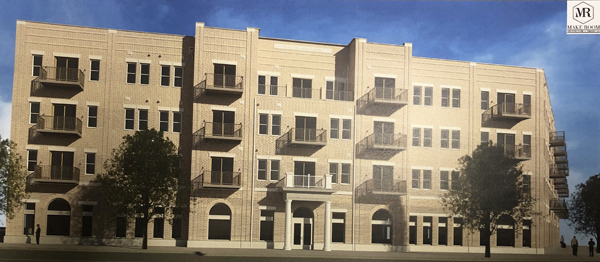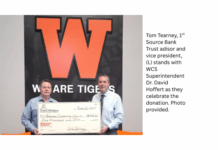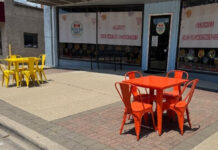
Warsaw Common Council on Monday received an update on the Buffalo Street project, approved a resolution awarding the Parks Department office/maintenance building project to GM Development Co. for an amount not to exceed $3.65 million and approved a declaratory resolution designating the former Kmart building an economic revitalization area.
Dave Matthews, from Matthews LLC, the developer for the Buffalo Street project, told the Council, “We built the first three shells of the town homes on Buffalo Street. The southern-most one is a model. The middle one is under contract; she should move in in January or February next year. The third one is still available.”
On the west side, he said they are building the mews – the tiny townhouses. Four are going up and they are being built to completion. The southern one should close around the third week of January and then they are waiting for buyers on the other three.
“We’ve done the demolition on the mixed-used portion of the project over by Center Lake,” Matthews said, referring to the old water company building, as a rendering of the planned building was displayed on a screen for the Council.
The mixed-used building will be four stories, with commercial on the first floor and room for a restaurant on the east side.
“Parkview Health has signed a lease to open a clinic up on the west side of the building. And then apartments on the second, third and fourth floors,” Matthews stated.
A site plan was then displayed for the Council. Parking will be on back but will be in two phases because of the parks building on the southeast corner still.
Councilwoman Diane Quance asked Matthews when does he expect to get started.
“That’s a great question. Right now we’re having challenges getting engineering drawings done. So the architectural drawings are done, but we’re waiting for an engineer to finish the work and sign off on it. So once that’s done, then financing and everything is lined up. It probably takes us three to five weeks to get through the state release program and then get building permits started,” Matthews replied.
Mayor Joe Thallemer said, “I think a lot of the challenges you’ll hear about tonight, as we talk about the BOT (Build Operate Transfer), I call them global supply chain challenges, are impacting not only materials but labor as well.”
The BOT came up under new business and is for the new Parks and Recreation Department offices and maintenance building. Before the Council approved the resolution awarding the BOT to Greg Martz, of GM Development Co., the Council heard a presentation on it, discussed it and had a public hearing for it over the course of about an hour.
Thallemer reminded the Council that it was about a year ago that they passed the original resolution allowing the city to use the BOT as a delivery method in the community. He said there’s been a lot going on in the last year, and they’ve been working to get the building project underway while the city also got caught up in the supply chain/construction cost inflation wave.
The city has a BOT Request For Qualifications and Proposals Committee (RFQP) that is required by state statute. It includes Thallemer, Council President Jack Wilhite, Community and Economic Development Director Jeremy Skinner, city engineer James Emans and Parks Superintendent Larry Plummer. The Committee made the recommendation Monday night to the Council to accept the resolution that the city award the BOT to Martz.
Providing a timeline of the project, Thallemer said with the displacement of the park offices and maintenance shed from the North Buffalo Street mixed-used project, back in 2019 the Park Board authorized Plummer to engage with Design Collaborative to combine the needs of both offices. In about July 2020, they came up with a design and a preliminary cost estimate.
As drawings and the floor plan of the building were put up on screen, Plummer said the first thing they looked at was the size of the building they needed now and 20 years down the road. He described the different areas of the new building, which would include a wash bay, two maintenance bays, two work bays, a locker room and offices. There’s a second floor for storage which, down the road, could be converted to more office space if needed.
Thallemer said the design was pretty much the original from 2020. The Committee tried to pare down costs, but, repeating what Plummer said, Thallemer said, “Everything we looked at to save money, we would go back to something less durable and with less longevity, and there really wasn’t that much savings at the end of the day.”
Skinner said, “One of the aspects we wanted, in the end, was we have a lot of money we’re putting into Buffalo Street and it’s important that our product is comparable to what is being put into Buffalo Street and keeping that design and that intent of that district that we’re trying to create.”
Skinner said project costs will continue to go up, but the Committee feels the building project design that was decided on meets the integrity of the district and the intent of what they’re trying to accomplish down on Buffalo Street. He said it’s reasonably priced to do that.
Thallemer said the original estimates for the project from about July 2020 were between $2.25-$2.5 million, based on the estimates from the architectural drawings.
“Certainly, we knew it was going to be more than that just knowing that once we brought things up to speed, with current prices and got materials list and went for full bid, it would be more than that,” he said.
A year ago, Thallemer said, that’s when it was decided they wanted to do the BOT for the project and that’s when they engaged Cameron Starnes from Taft Law to guide them through the BOT.
“It is a very popular process in many communities because it really takes the construction risk out of our hands from the traditional Bid-Build. It also gives us a guaranteed maximum price. It allows us to choose who we want for the project,” Thallemer explained. “So tonight the process is formalizing our selection of our developer.”
Emans told the Council about the pricing he’s seen in projects. “We’ve had a multitude of projects, three or four, and all of that have come in from anywhere from 30 to 60 percent over the engineer’s estimate. It’s not because the contractors are paying their staff more. It’s primarily because of the shortage of materials, and to get those materials to be effective on the project, contractors are paying a premium.”
Todd Samuelson, partner with Baker Tilly, spoke about how the city was going to buy down the project with capital funds and then the remaining $2 million would be put into a bond in 2023. The city also talked about a new building for the street department.
Starnes talked about how the BOT is a delivery method for public projects and how change orders must be approved by the Council. Martz talked about how costs have risen just this year but he guarantees the cost for the project to the city will not be over the maximum of $3.6 million no matter what.
The Council unanimously approved the resolution to award the contract to GM Development. There were no remonstrators against it during the public hearing.
The last resolution of the night was a declaratory resolution for the designation of a economic revitalization area, presented by Steve Snyder, on behalf of AJM LLC.
He said AJM LLC is in the process of purchasing the old Kmart building and upgrading it for the purpose of establishing a Rural King.
“As you are aware, there are a couple of things we are requesting. One is the designation of that particular area as an economic revitalization area, which would provide some eligibility to the owner of the building to request tax abatement. We’re doing that simultaneously and have submitted the SB-1 form that is specifically applicable to vacant buildings,” Snyder said.
The SB-1 can only be filed where there is a building that has been vacant for at least one year. The old Kmart building “meets that without any questions,” he said. Monday’s meeting was to preliminary designate the ERA and initially approve the SB-1 statement that AJM has filed.
Snyder said the former Kmart building has been vacant for over a year and there have been extensive efforts to find tenants or sell the building, but those failed. As a result, the building qualifies for an abatement as a vacant building.
“What’s being proposed by Rural King is to put $1.5 million in improvements in the building first of all. Generate 55 new jobs, full-time equivalent jobs, at an average pay of $14.80 an hour. Times 40 times 55 times 52 comes out to the creation of salaries of about $1.7 million every year,” Snyder said.
Other benefits that come with Rural King include that it draws not just from Warsaw and Kosciusko County, but also from adjacent areas. The appearance of the building “certainly will be enhanced,” Snyder said, and it assures that shopping center of continued life.
The tax abatement, if the Council eventually approves it, will be for five years.
The declaratory resolution approved on Monday allows a public hearing in Jan. 18 and the formal approval of the ERA with a confirmatory resolution and the statement of benefits. The ERA’s confirmatory resolution would apply only to the former Kmart section of the shopping center, not the entire complex, and some of the parking lot.
Councilman Jerry Frush said he was glad to see Rural King coming in and, “I think it will be an asset to Warsaw.”
The Council unanimously approved the declaratory resolution.




